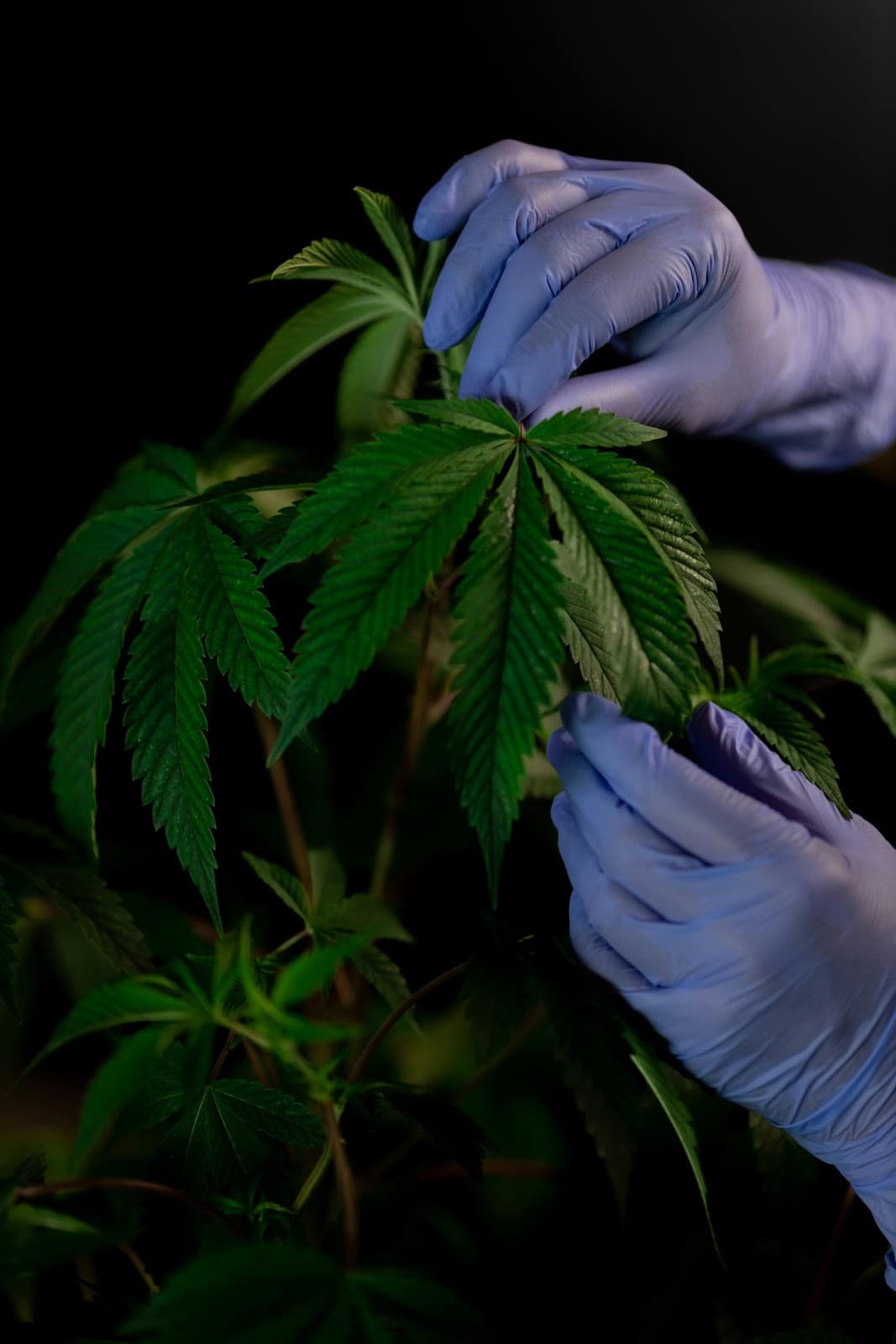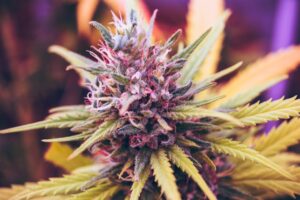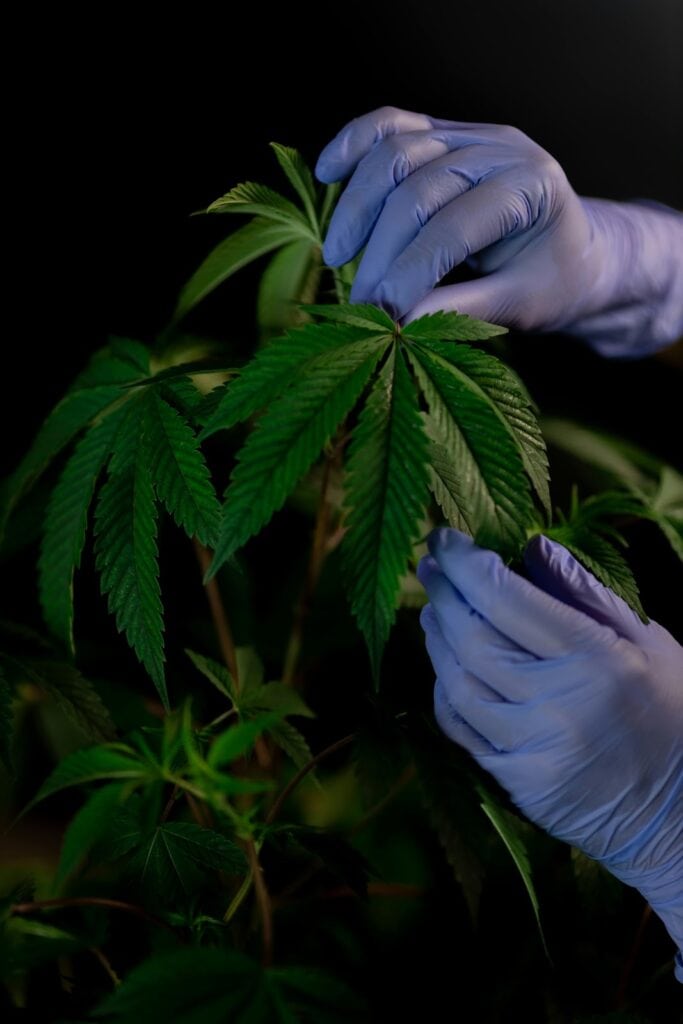
For beginner growers, raising cannabis at home can be fun and rewarding. This guide explains cannabis growing basics and provides the first steps to get started with growing cannabis at home for personal use.
Key Points
- Learn how different strains make you feel before choosing one to cultivate.
- Indoor or outdoor growing spaces need the right tools.
- Learn about cannabis plant maintenance and seed germination.
- It’s best to know when and how to collect your cannabis.
- Keep current with home-grow cannabis legislation and community tools.
Basic Cannabis Knowledge
Different Strains’ Effects
Understanding cannabis kinds is crucial when growing it at home. The main types are three:
- Sativa makes individuals feel pleasant and is best utilized during the day.
- Indica cannabis soothes and relaxes, making it ideal for relaxing.
- Although less widespread, Cannabis Ruderalis is utilized to generate auto-flowering plants.
Choose based on your desired feeling because each kind has different effects!
What the Law Says About Growing Cannabis at Home
Find out the local laws before growing cannabis at home. Some things to consider:
- Is it legal to grow marijuana where you live?
- How much marijuana are you allowed to grow at a particular time?
- What type of cannabis use is legal in your state, recreational, medicinal, or both?
Know your local cannabis control laws to avoid difficulties.
Prepare Your Growing Area
First, choose a good spot to cultivate your cannabis. New cannabis cultivators should know that your environment can make or break your homegrown marijuana farm. Look at these:
Picking the Right Place
Inside or out? Choose between an indoor farm or greenhouse plant growth. Each has pros and cons.
Give plants room to grow. They need space!
Watering your plants is a necessity, so choose a location with easy access to water.
Indoor vs Outdoor Growing
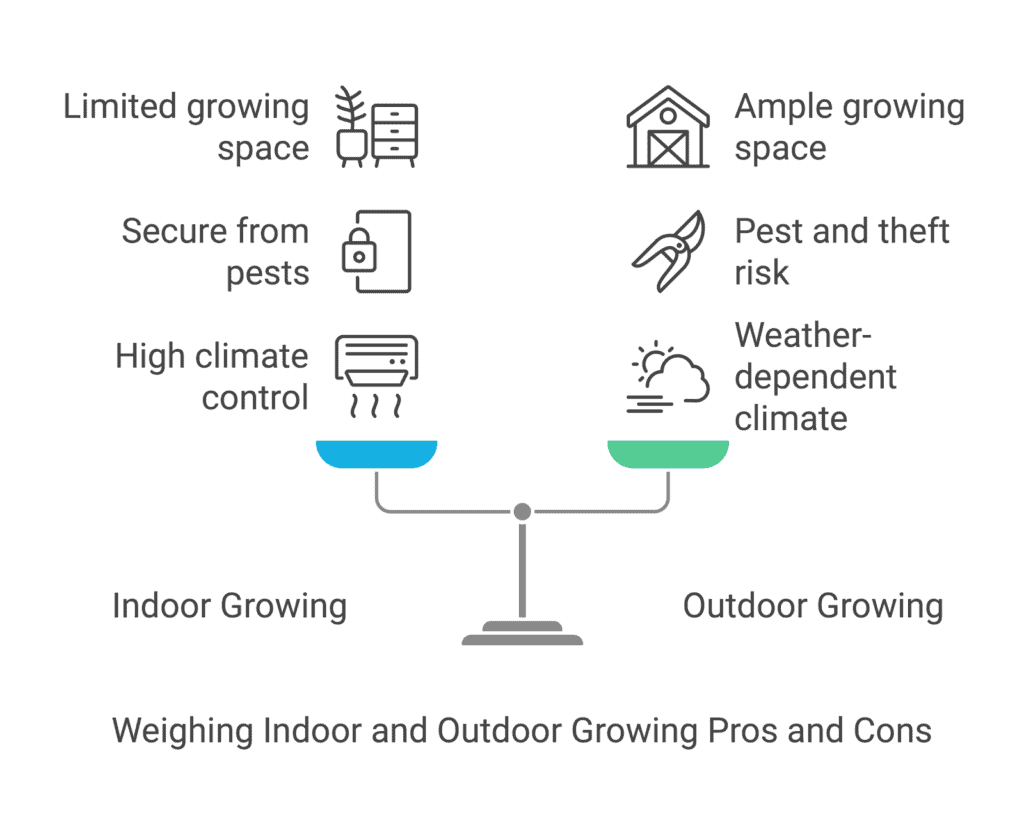
| Factor | Indoor Growing | Outdoor Growing |
| Control Over Climate | High (you control light, temp) | Low (depends on weather) |
| Security | More secure from pests | Risk of pests and theft |
| Space | Limited by your room size | Usually more space available |
Essential Tools for Beginners
To begin, you need:
- Grow Lights: Give your plants enough light with suitable lighting.
- Airflow system: Prevents mold growth.
- Pot selection: Choose containers with adequate drainage and space for root growth.
Germinating Your Seeds
Selecting Good Seeds
Growing cannabis starts with choosing the right seeds. A successful crop requires healthy seeds. Good seeds are black and firm, not loose or light. For the best seeds, choose reputable sources.
Seed Germination: Step-by-Step
How to cultivate those seeds:
- Start by soaking the seeds for 12–24 hours. This softens the seed coat and initiates sprouting.
- After soaking, plant seeds in a tiny container with damp earth. Bury them 0.5–1 inch deep. Lightly cover them with soil and push them down to make sure they stay.
- Guard your seeds. To sprout in a few days to a week, keep the soil moist but not soggy and the temperature between 70°F and 90°F.
Mistakes to Avoid
- Overwatering: Using too much water on your seeds may drown your homegrown cannabis. The soil should be moist but not wet.
- Not considering temperature: Warmth pleases cannabis seedlings. Maintaining the temperature between 70 to 85 degrees Fahrenheit helps them flourish.
- Using bad soil: Use nutrient-rich soil to start seedlings.
This early stage requires patience. Give your seeds the care they need as they grow.
Caring for Your Cannabis Plants
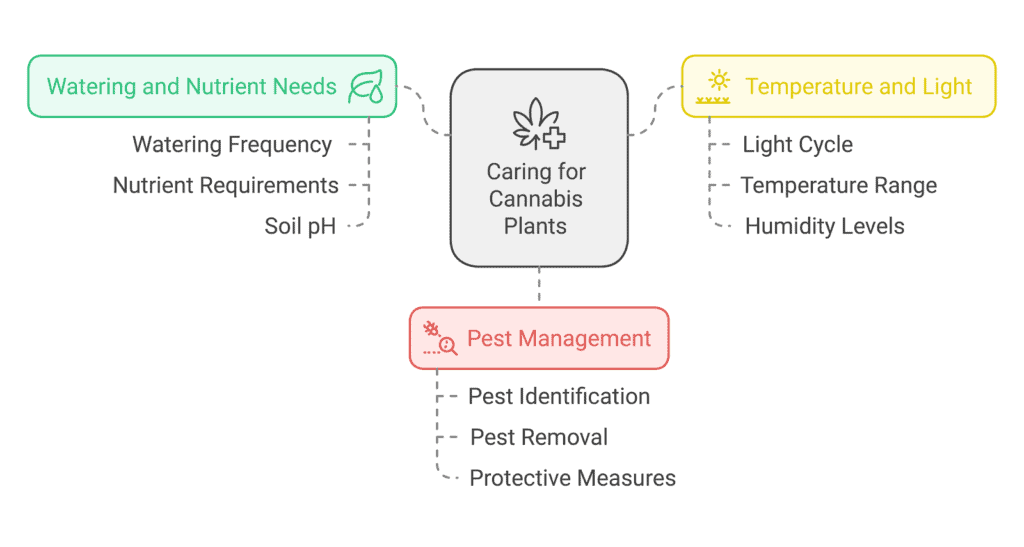
Home cannabis growers must take care of their plants. Keep them happy and healthy with these:
Watering and Nutrient Needs
- When the top inch of dirt feels dry, you should water your plants. Don’t water too much or risk root rot!
- Cannabis plants need nitrogen, phosphorus, and potassium. Use cannabis-specific fertilizer to keep plants healthy.
- Monitor soil pH. For the most nutrients, aim for 6.0–7.0.
Maintaining Temperature and Light
- Your plants require 18–24 hours of sunshine to grow. Change the light cycle to 12/12 when flowers appear.
- A temperature of 70 to 85°F is excellent. Plants might get stressed out when it’s too hot or too cold.
- Start with 60–70% moisture and reduce to 40% as plants grow.
How to Find and Remove Pests
- Most individuals fear aphids and spider mites. Without prompt detection, they might damage your plants.
- Check for yellow leaves or droppings on the webs of your plants. These might indicate pests or diseases.
- Use natural or organic chemicals to protect your plants without harming the environment.
Remember that responsible cannabis cultivation requires attention to your plants’ needs. Happy plants produce beautiful flowers.
Bud Selection and Curing
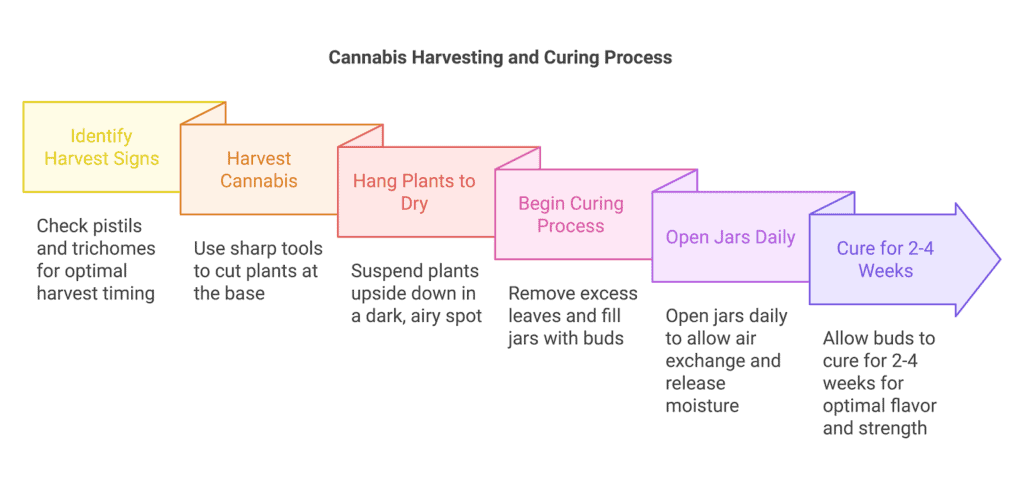
Knowing When to Harvest
Cannabis should be harvested at the correct time. Keep a watch out for these signs:
- Pistils should be 70–90% brown.
- Trichomes, small crystals on buds, may be examined using a magnifying glass. About half should be gold for optimal results.
- Must not be too clear or brown. Too much clarity is premature.
How to Harvest Right
These steps can help you cut when ready:
- Use sharp scissors or pruning shears to cut the plants at the base.
- Be gentle! The trichomes hold all the beneficial stuff, so you don’t want to harm them.
- Hang plants upside down in a dark, airy spot to dry.
Curing for Maximum Benefit
After drying, cure your buds. This stage is crucial for flavor and strength:
- Remove stem buds and excess leaves.
- Only fill glass jars three-quarters full with buds.
- For the first week, open the jars daily to admit air and release water. This deters microorganisms.
- You should let them cure for 2–4 weeks.
Patience is crucial! Let it cure longer for a better effect.
Storing Your Final Product
- After drying, store buds in cold, dark, airtight containers. Avoid light, heat, and water to keep them healthy.
If you accomplish these things, you’ll enjoy cannabis and be ready to share or sell your cultivated buds if your state and local laws allow it!
How to Fix Common Issues
Dealing with Nutrient Deficiencies
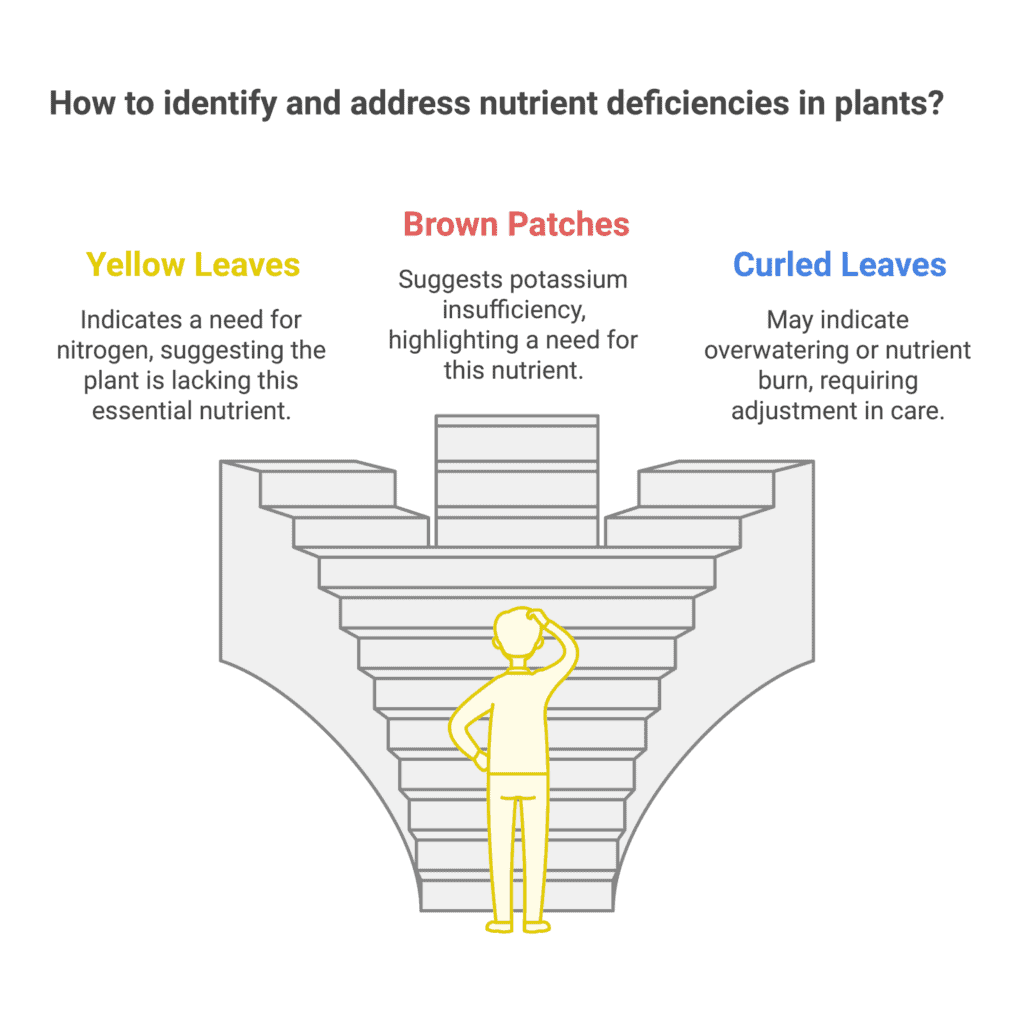
Some nutrients may be insufficient, therefore check for these signs:
- If your plant’s leaves are turning yellow, especially older ones, it could mean that it needs nitrogen.
- Brown patches may suggest potassium insufficiency.
- A plant with curled leaves may be overwatered or nutrient burnt.
Change how often you feed your plants and give them the right ingredients for their stage of growth to fix these issues. Balance is essential!
Signs of Plant Stress
Some don’t realize how stressed plants look, yet here are some signs:
- When leaves droop, plants may be thirsty or overwatered.
- Discoloration may indicate nutritional or light issues.
- Slow-growing plants may not like their environment.
If you encounter these indications, examine your environment. Small changes may make a big difference.
Prevention of Mold and Mildew
Mold and mildew prevention can preserve your crop:
- Keep your grow area airy. Overcrowding keeps air static, promoting mold development.
- Check humidity, especially when the plant blooms. Aim for 40–50% humidity.
- Check your plants often for mold or mildew and remove it immediately.
Remember that cannabis cultivation is an obligation. Know your local plant growth limits. So enjoy your hobbies without worrying about the law!
Developing Your Skills
Try More Sophisticated Techniques
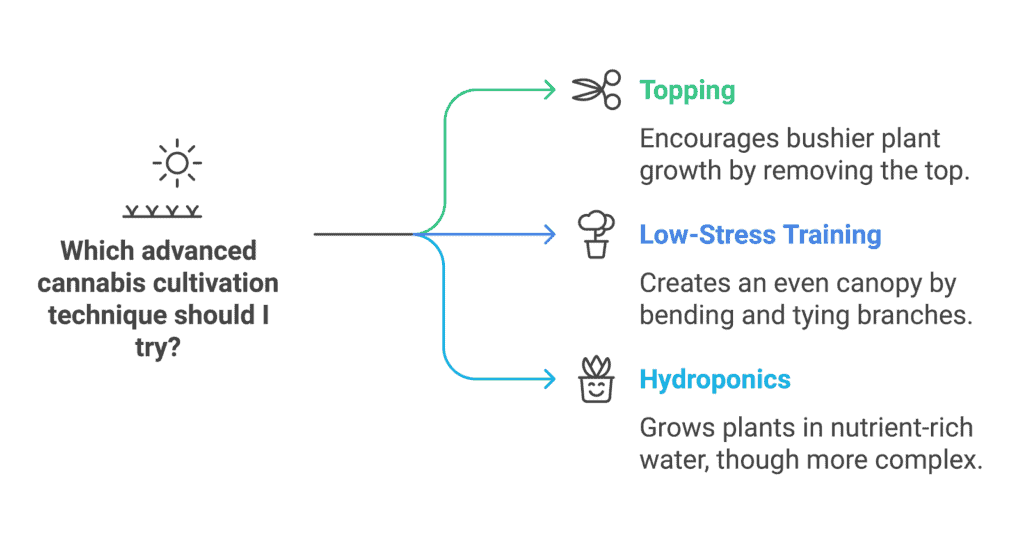
Grow your own cannabis for fun. Move up once you know the basics! Some great things to do:
- Topping: This includes cutting off the plant’s top for bushier growth.
- Low-Stress Training: Forming an even canopy by gently bending and tying branches.
- Hydroponics: Hydroponics grows plants in nutrient-rich water. Though difficult, it’s worth it!
We Can Learn from Cannabis Users
You’re not alone in this journey! Connect with other cultivators to share tips and tricks. Here’s how:
- Join social media or forums.
- Attend local cannabis events or classes.
- Following experienced growers on YouTube provides visual aid.
Keeping Up with Legal Changes
Cannabis laws change, so be informed. Do these:
- Check neighborhood home cultivation laws often.
- Subscribe to cannabis-supporting newsletters.
- Follow cannabis law news sites.
As you learn, your plants will grow better! Trying new strains and procedures can yield amazing results. Growing decent cannabis at home saves money.
Bottom Line
Congratulations! You now know how to develop plants, from selecting seeds to harvesting and curing buds. Raise your plants well and offer them the ideal environment to watch them flourish. Enjoy the flavor and benefits of your homegrown cannabis and be proud of your hard work and creativity.
Frequently Asked Questions
How do I cultivate cannabis at home?
To start cultivating cannabis, you’ll need decent seeds, a good growth medium (like soil), pots or containers, grow lights, and a means to water the plants. Find out your local weed-growing laws!
Can I tell when to harvest my cannabis plants?
Your cannabis plants are ready to harvest when most of the pistils are brown and the trichomes are half amber. It usually signifies the buds are ready to pluck.
How should cannabis be treated after harvesting?
Let cannabis dry for a week in a dark, airy room after harvesting. Then, seal the dried buds in jars. Open the jars daily for a few weeks to allow the blooms to breathe. This improves the flavor and strength better.
Can I grow marijuana indoors and out?
Cannabis can be grown indoors and out! You have greater control over the environment when you grow plants indoors, but you can use natural sunshine when you grow plants outside. Choose what suits you!
What should I do if my plants are stressed?
Plants that seem unwell may have pests, nutrition, or water issues. Change circumstances if needed and explore challenges to discover the best solutions.
Can I cultivate cannabis at home?
Growing cannabis at home may be allowed in your state. Check your local laws to see how many plants you may grow and other restrictions.

